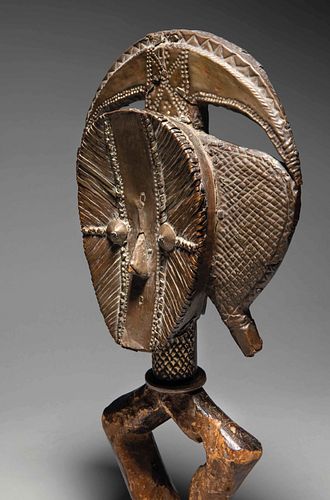Kota Obamba reliquary figure. Kota people, Gabon, 19th century. Wood covered with copper plates.
Lot 88
About Seller
Setdart Auction House
Carrer Aragó 346
Barcelona
Spain
Setdart Subastas was born in 2004 and is currently the first online art auction in Spain with solidity, prestige and reliability guaranteed by our more than 60,000 users. Setdart has a young, dynamic and enterprising team ready to successfully manage the purchase and sale of art works through custom...Read more
Categories
Estimate:
$100,000 - $120,000
Absentee vs Live bid
Two ways to bid:
- Leave a max absentee bid and the platform will bid on your behalf up to your maximum bid during the live auction.
- Bid live during the auction and your bids will be submitted real-time to the auctioneer.
Bid Increments
| Price | Bid Increment |
|---|---|
| $0 | $10 |
| $200 | $25 |
| $500 | $50 |
| $1,000 | $100 |
| $3,000 | $200 |
| $5,000 | $500 |
| $10,000 | $1,000 |
| $20,000 | $2,000 |
| $50,000 | $5,000 |
About Auction
By Setdart Auction House
Jun 17, 2021
Set Reminder
2021-06-17 06:15:00
2021-06-17 06:15:00
America/New_York
Bidsquare
Bidsquare : 19th & 20th Century Contemporary Art - Select Lots
https://www.bidsquare.com/auctions/setdart-auction-house/19th-20th-century-contemporary-art---select-lots-7081
Setdart Auction House sofia@setdart.com
Setdart Auction House sofia@setdart.com
- Lot Description
Kota Obamba reliquary figure. Kota people, Gabon, 19th century. Wood covered with copper plates. Origin: - Private collection, France. - Private collection, Spain. Measurements: 42 cm. This type of figures, carved in wood and covered with sheet metal, were used to guard the relics of ancestors. In this guardian, the meticulous work of the copper, chiseled and based on parallel lines that represent feathers or fabrics, is especially noteworthy. Also noteworthy is the expressiveness of the face, with large round, applied eyes. The Kota or Bakota belong to the Bantu ethnic group, and come from the northeast of Gabon. It is a patriarchal society, although some subgroups are organized around a matrilineal lineage system. In the past, the Kota used to leave their dead exposed to the elements of the forest. Influenced by neighboring tribes, they began to bury their chiefs and then exhume their bones to place them with other objects charged with magical powers in boxes or baskets of bark, called bwété. The bwété were the central point of offerings and prayers intended to bring prosperity to the clan. On top of these, a sculpture with a stylized diamond-shaped body and a large head covered with copper leaves was placed. The back of the head was usually left in a rough state, but sometimes a geometric pattern is highlighted as in the present specimen. The most prominent features of this style, called Obamba, are the curved side extensions, the transverse crest attached to these side caps, the face blades radiating from the center of the oval on either side of the central plate, and the decorative motifs on the crest and neck.
- Shipping Info
-
In-house shipping available. Please inquire at admin@setdart.com.
-
- Buyer's Premium



 EUR
EUR CAD
CAD AUD
AUD GBP
GBP MXN
MXN HKD
HKD CNY
CNY MYR
MYR SEK
SEK SGD
SGD CHF
CHF THB
THB













